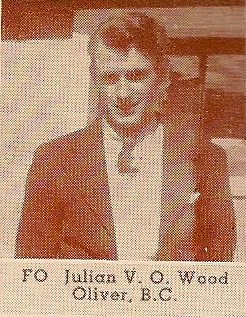Wood, Julian Vernon Orison
Personal Information
| Rank | F/O |
| Forename(s) | Julian Vernon Orison |
| Surname | Wood |
| Gender | M |
| Age | 22 |
| Decorations | |
| Date of Death | 13-05-1943 |
| Next of Kin | Son of Douglas Vernon Wood and Hilga Violet Wood (née Gwat), of Vancouver, British Columbia, Canada. Husband of Elizabeth (Betty) Neil Wood (née Sneddon), whom he married in January 1943 at Oakham, Rutland. |
Aircraft Information
| Aircraft | Avro Lancaster I |
| Serial Number | W4269 |
| Markings | QR-G |
Memorial Information
| Burial/Memorial Country | Netherlands |
| Burial/Memorial Place | Amsterdam New Eastern Cemetery |
| Grave Reference | Plot 69. Row C. Coll. grave 10. |
| Epitaph |
IBCC Memorial Information
| Phase | 1 |
| Panel Number | 118 |
Enlistment Information
| Service Number | J/22547 |
| Service | Royal Canadian Air Force |
| Group | 5 |
| Squadron | 61 |
| Trade | Air Bomber |
| Country of Origin | Canada |
Miscellaneous Information
| Julian was born at Vancouver, British Columbia on 14 January 1921. His father was born at Vernon, British Colombia and worked as an electrical engineer and a farmer, and his mother born at Bon Accord, Edmonton, Alberta. Little more seems known about his family but he did have a married sister, Yvonne McDonald. The schools he attended were MacLean Public School 1927-1934, John Oliver High 1934-1938 and Salmon Arm High 1939-1943. Between 1938-1939 he is shown as being in the Department of Education, British Columbia. His sport interests were basketball and track events. He spent five years in the Scouts and was a Scout leader and a King’s Scout. Julian took on seasonal work during 1939 where he was a syrup maker for Dominion Canners and then worked there as a labourer between 1940-1941. |
| He enlisted on 29 August 1941 and after training was posted to the U.K. He embarked from Canada on 7 August 1942 and after arriving at 3PRC on 19 August he went to 3(0) AFU 26 August 1942, 14 OTU on 22 September 1942, 1660 CU. 9 February 1943, 617 Sqn 31 March 1943 and 61 Squadron on 11 April 1943. Sadly Julian lost his life from 61 Squadron shortly afterwards on 13 May 1943. |
| Betty was serving with the WRAF. She moved to Canada to live with Julian's parents after the war. |
Commonwealth War Graves Commission
The National Archives
| Record of Events (Operational Record Book) AIR 27/578/10 |
| Summary of Events (Operational Record Book) AIR 27/578/9 |
Fellow Servicemen
Last Operation Information
| Start Date | 12-05-1943 |
| End Date | 13-05-1943 |
| Takeoff Station | Syerston |
| Day/Night Raid | Night (56% moon) |
| Operation | Duisburg |
| Reason for Loss | Hit by flak and crashed onto the Zuiderzeepark highway in Amsterdam |
